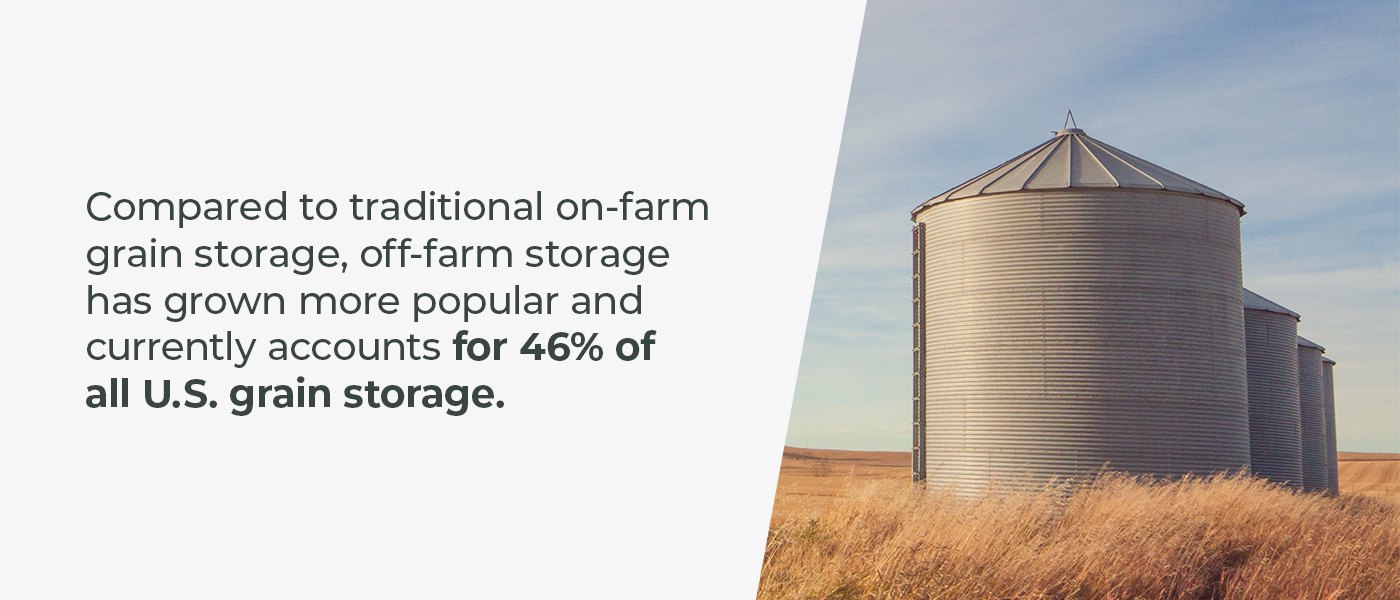Since humans first started harvesting and processing grains, there has been a need for grain storage. The ability to store grain means residential and commercial farmers can keep crops throughout the season and feed livestock or save it until they can sell it for the best possible market price. Successful grain storage requires a dry, aerated area raised off the ground and protected from the elements.
Contact Us For Our Grain Storage Solutions
Other factors, like temperature and the environment, also play a significant role in the product’s quality. Unfortunately, early hunter-gatherers and farmers did not have access to the same innovations as the agricultural community does today.
Read on to learn more about the history of grain storage, including what you can expect to see in future grain storage innovations.
The Beginning: Early Grain Storage Techniques
Early people needed a sustainable way to store grain for use over long winters. Food preservation allowed communities to stay in one place, establishing towns and cities without the need to travel for food or better conditions. Some of the earliest forms of grain storage utilized baskets, sacks and jars. Some communities had a separate storehouse where they kept grain inside in a large pile. In some societies, these storehouses may have also acted as a sort of social gathering place for hunter-gatherers.
Of course, these methods weren’t sustainable — jars, sacks and baskets are only suitable for short-term use and small portions of grain. Open or exposed storehouses left the grain vulnerable to rats, bacteria, insects, moisture and parasites.
Archaeological evidence suggests that very early forms of the silo existed nearly 11,000 years ago, years before crop domestication became widespread. Early people likely used them to fight against famine. They predominantly stored barley and wheat, and the silos had raised platforms and slight slopes for drainage and moisture protection. There have also been early silos discovered in South Egypt that were large enough to support an entire urban community — something previously unheard of for the time.
Fred Hatch, a farmer from Illinois, built what is believed to be America’s first variation of the modern silo in 1873 after trying to figure out how to store grain at his family farm while also combating grain spoilage. Within the next several years, silos slowly popped up in other parts of the country, though many were skeptical of the idea.
Some early silos were horizontal with squared corners, called pit silos. These were either partially or entirely dug into the ground and then lined with rocks or straw to absorb any ground moisture. However, this square shape started to bow and allowed air pockets to form in the corners — conditions that lead to rampant grain rot. This led to the evolution of the rounded silo we know today.
Early rounded silos consisted of brick, wood and cement — not quite as cost-efficient or durable as the steel silos you see now. They were also more dangerous than the average grain storage facility of today’s farms. Farmers had to climb inside and perform intense labor to pitch the grains until the invention of the automatic unloader in the 1940s.
Grain Storage Evolution
Small-scale storage evolved from baskets, jars and sacks to more sophisticated grain storage bins. These bins kept the crop safe from the elements and elevated from the ground. Over time, innovations have further improved grain bin efficiency, with features like perforated floors for retrofitting existing crop storage to new ones, moisture and temperature control mechanisms and varying bin depths. These innovations have also made grain storage more accessible for different types of properties, homes and businesses.

Grain Storage Systems Today
Thanks to modern technology, storing grain safely and efficiently is easier than ever. Commercial and residential farmers have their choice of silos, bins, elevators, bunkers or sheds. Some countries use other methods, like earth pots, granaries, mud and thatched rhombuses, bamboo houses or underground pits lined with straw and husk and topped with protective wood or polyethylene to protect the contents.
Storage capacity has also grown — in 2018 alone, on- and off-farm storage capacity reached nearly 25 billion bushels of grain in the United States. This capacity grows as a response to increased crop production. Though it’s unlikely that storage capacity will grow at a faster pace, there is a stronger focus on improving the quality of that storage, like interior conditions and farmer safety.
Compared to traditional on-farm grain storage, off-farm storage has also grown more popular and currently accounts for 46% of all U.S. grain storage. This is likely due to the flexibility that off-farm storage provides, like management assistance. Some farmers are even renting grain storage solutions for their own properties to optimize farms for grain profit without committing to full-scale storage system builds.
New Technology Adds More Ways to Store Grain
Just as it is in other industries, technology continues to revolutionize agriculture. For grain storage, this means systems with faster fill rates than before, aerator technology, flow retarders, dust suppressors and enhanced safety equipment. Smart technology has led to the development of portable grain monitoring solutions, so farmers can get all the information they need about the conditions inside their storage facilities without manually inspecting them themselves. This is a process that would otherwise take up valuable work time.
Some of these systems include emergency alerts, so farmers can learn about issues or potential hazards before they turn into costly waste or equipment damage. These alerts also make it easier to diagnose problems.
Custom Storage Methods
Custom storage methods like those from LCDM offer farmers even more control, with products like adjustable cushion boxes, slide gates and flow retarders. LCDM also provides application-specific components and layouts to meet your specific needs, including 3D concepts, construction mockups and comprehensive design support for a functional system that meets your current needs and remains easily scalable for the future.
Grain Storage of the Future
Grain storage of the future will continue seeking new and more efficient ways to optimize the storage process and make the environment safer for workers. Smart farming — or farming that utilizes smart technology — will likely bring advancements such as more sophisticated condition management sensors, agnostic software for troubleshooting, additional robotic elements and easier ways to harness important storage data to make better decisions for farms and businesses.
Get Grain Storage Solutions From LCDM
Though grain storage has evolved significantly over generations, there is still room to grow. LCDM grew from a need for better, safer and more efficient grain storage and management equipment. We are always striving to use the latest technologies and innovations to create solutions for residential and commercial farmers everywhere.
Learn more about our heritage and shop our grain storage and distribution equipment today.



Trackbacks/Pingbacks